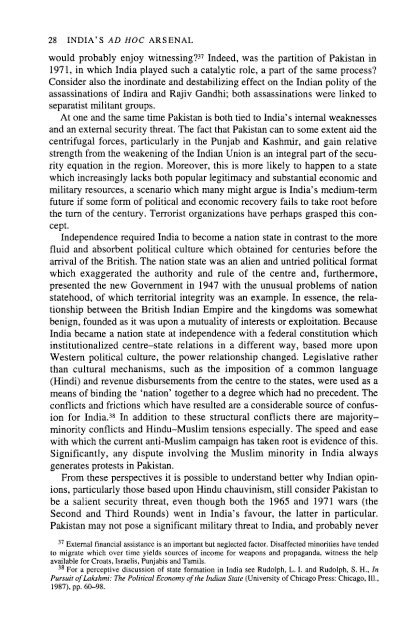India's Ad Hoc Arsenal - Publications - SIPRI
India's Ad Hoc Arsenal - Publications - SIPRI
India's Ad Hoc Arsenal - Publications - SIPRI
- No tags were found...
You also want an ePaper? Increase the reach of your titles
YUMPU automatically turns print PDFs into web optimized ePapers that Google loves.
28 INDIA'S AD HOC ARSENALwould probably enjoy ~itnessing?3~ Indeed, was the partition of Pakistan in1971, in which India played such a catalytic role, a part of the same process?Consider also the inordinate and destabilizing effect on the Indian polity of theassassinations of Indira and Rajiv Gandhi; both assassinations were linked toseparatist militant groups.At one and the same time Pakistan is both tied to <strong>India's</strong> internal weaknessesand an external security threat. The fact that Pakistan can to some extent aid thecentrifugal forces, particularly in the Punjab and Kashmir, and gain relativestrength from the weakening of the Indian Union is an integral part of the securityequation in the region. Moreover, this is more likely to happen to a statewhich increasingly lacks both popular legitimacy and substantial economic andmilitary resources, a scenario which many might argue is <strong>India's</strong> medium-termfuture if some form of political and economic recovery fails to take root beforethe turn of the century. Terrorist organizations have perhaps grasped this concept.Independence required India to become a nation state in contrast to the morefluid and absorbent political culture which obtained for centuries before thearrival of the British. The nation state was an alien and untried political formatwhich exaggerated the authority and rule of the centre and, furthermore,presented the new Government in 1947 with the unusual problems of nationstatehood, of which territorial integrity was an example. In essence, the relationshipbetween the British Indian Empire and the kingdoms was somewhatbenign, founded as it was upon a mutuality of interests or exploitation. BecauseIndia became a nation state at independence with a federal constitution whichinstitutionalized centre-state relations in a different way, based more uponWestern political culture, the power relationship changed. Legislative ratherthan cultural mechanisms, such as the imposition of a common language(Hindi) and revenue disbursements from the centre to the states, were used as ameans of binding the 'nation' together to a degree which had no precedent. Theconflicts and frictions which have resulted are a considerable source of confusionfor India.38 In addition to these structural conflicts there are majorityminorityconflicts and Hindu-Muslim tensions especially. The speed and easewith which the current anti-Muslim campaign has taken root is evidence of this.Significantly, any dispute involving the Muslim minority in India alwaysgenerates protests in Pakistan.From these perspectives it is possible to understand better why Indian opinions,particularly those based upon Hindu chauvinism, still consider Pakistan tobe a salient security threat, even though both the 1965 and 1971 wars (theSecond and Third Rounds) went in <strong>India's</strong> favour, the latter in particular.Pakistan may not pose a significant military threat to India, and probably never37 External financial assistance is an important but neglected factor. Disaffected minorities have tendedto migrate which over time yields sources of income for weapons and propaganda, witness the helpavailable for Croats, Israelis, Punjabis and Tamils.38 For a perceptive discussion of state formation in India see Rudolph, L. I. and Rudolph, S. H., InPursuit of Lakshmi: The Political Economy of the Indian State (University of Chicago Press: Chicago, Ill.,1987), pp. 60-98.
















